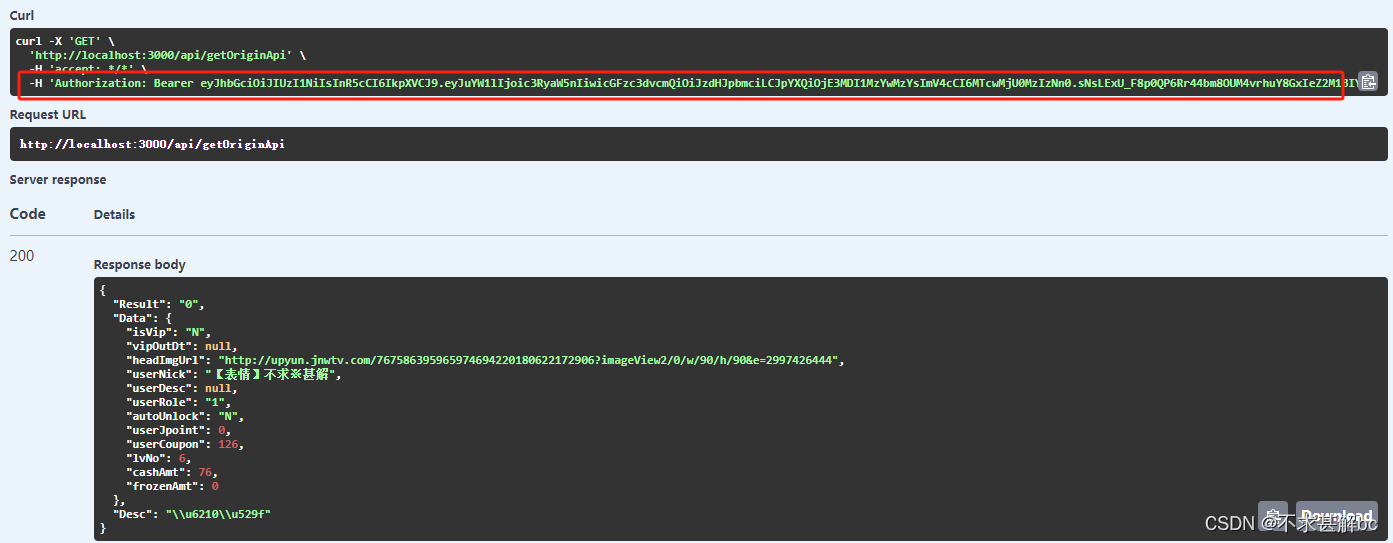目标
nestjs经常需要设置一些鉴权(登录后)才能访问的接口,但是生成的swagger文档可以发起接口请求,文档发起的请求默认是不携带登录token的,所以需要移除swagger文档发起请求的守卫拦截。
nestjs守卫拦截设置见另一篇博客 nestjs守卫/全局守卫校验jwt-CSDN博客
方案一
关闭swagger文档请求守卫拦截
global.guard.ts
import { Injectable, NestInterceptor, ExecutionContext, HttpException, HttpStatus } from '@nestjs/common';@Injectable()
export class GlobalGuard implements NestInterceptor {intercept(context: ExecutionContext, next): Observable<any> {const request = context.switchToHttp().getRequest();// 判断是否是swagger文档访问,如果请求头referer包含/api-docs,则认为是swagger文档访问// 文档前缀在main.ts设置,本项目文档前缀设置的api-docsconst apiDocAccess = request.headers['referer'].indexOf('/api-docs') > -1;if (!apiDocAccess) {// 非文档访问、需要鉴权才能访问的接口,执行鉴权逻辑// ...}// 其他场景直接放行return next.handle();}
}方案二
swagger文档添加鉴权请求头信息
接口添加 jwt 鉴权后,接口文档调用接口请求头没有添加 authorization,请求会返回403。为此,需要给文档需要鉴权的接口请求头也添加 authorization
main.ts 配置 BearerAuth 校验
const config = new DocumentBuilder().setTitle('接口文档').setDescription('接口文档描述').setVersion('1.0').addBearerAuth() // 注意此处:文档添加BearerAuth.build();
const document = SwaggerModule.createDocument(app, config);
SwaggerModule.setup('api-docs', app, document); // 文档前缀设为 api-docs在需要鉴权的接口添加 @ApiBearerAuth() 装饰器
import { ApiBearerAuth } from '@nestjs/swagger';@Controller('api')
@ApiBearerAuth() // 在此处添加,表示/api/的接口请求头全都需要添加authorization
export class ApiController {@Get('getUserInfo')@UseGuards(AuthGuard)@ApiBearerAuth() // 在此处添加,表示当前接口请求头需要添加authorizationgetUserInfo(): any {return this.apiService.getUserInfo();}
}使用
先调用登录接口获取到 jwt_token

注意:可以设置默认请求参数,参数用一个swagger测试账号,就不用每次调用再改参数了。设置方法如下:
class LoginDto {@ApiProperty({description: '用户名', default: 'swagger-test'})name: string@ApiProperty({description: '密码', default: '123456'})password: string
}点击文档顶部Authorize按钮

输入获取到的 jwt_token,并点击Authorize,然后关闭弹窗

再调用需要鉴权的接口,就可以鉴权通过了

注意:请求头的 Authorization 参数会在最前面添加 Bearer 字符,可以在守卫中将此字符移除
this.jwtService.verify(token.replace('Bearer ', ''))
















与消息队列ActiveMQ基本使用(一))


